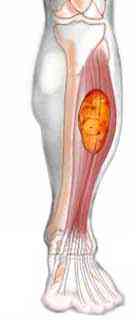| Adult soft tissue sarcoma is a
disease in which malignant (cancer) cells form in the soft tissues of the body.
The soft tissues of the body include the muscles, tendons
(bands of fiber that connect muscles to bones), fat, blood vessels, lymph vessels, nerves,
and tissues around joints. Adult soft tissue sarcomas can form almost anywhere in the
body, but are most common in the legs, abdomen, arms, and trunk. There are many types of
soft tissue sarcoma. One type that forms in the wall of the stomach, intestines, or rectum
is called a gastrointestinal stromal tumor (GIST). The cells of each type of sarcoma look
different under a microscope, based on the type of soft tissue in which the cancer began.
Having certain inherited disorders can increase
the risk of developing adult soft tissue sarcoma.
Anything that increases your risk of getting a
disease is called a risk factor. Risk factors for soft tissue sarcoma include the
following inherited disorders:
Retinoblastoma.
Neurofibromatosis type 1 (von Recklinghausen disease or NF1).
Tuberous sclerosis.
Familial adenomatous polyposis (FAP).
Li-Fraumeni syndrome.
Werner syndrome.
Basal cell nevus syndrome.
Other risk factors for soft tissue sarcoma include
past treatment with radiation therapy during childhood or for the following types of
cancer:
Retinoblastoma.
Breast cancer.
Lymphoma.
Cervical cancer.
Possible signs of adult soft tissue sarcoma
include a lump or swelling in soft tissue of the body.
A sarcoma may appear as a painless lump under the
skin, often on an arm or a leg. Sarcomas that begin in the abdomen may not cause symptoms
until they become very large. As the sarcoma grows larger and presses on nearby organs,
nerves, muscles, or blood vessels, symptoms may include: Pain. Trouble breathing.
Adult soft tissue sarcoma is diagnosed with a
biopsy. If a soft tissue sarcoma is suspected, a biopsy will be done. The type of biopsy
that is done will be based on the size and location of the tumor. There are two types of
biopsy that may be used:
Incisional biopsy: The removal of part of a lump
or a sample of tissue.
Core biopsy: The removal of tissue using a wide needle.
Samples will be taken from the primary tumor,
lymph nodes, and other suspicious areas. A pathologist views the tissue under a microscope
to look for cancer cells and to find out the grade of the tumor. The grade of a tumor
depends on how abnormal the cancer cells look under a microscope and how quickly the cells
are dividing. High-grade tumors usually grow and spread more quickly than low-grade
tumors. Because soft tissue sarcoma can be hard to diagnose, patients should ask to have
biopsy samples checked by a pathologist who has experience in diagnosing soft tissue
sarcoma.
Certain factors affect treatment options and
prognosis (chance of recovery).
The treatment options and prognosis (chance of
recovery) depend on the following:
The type of soft tissue sarcoma.
The size, grade, and stage of the tumor.
Where the tumor is in the body.
Whether the entire tumor is removed by surgery.
The patient's age and general health.
Whether the cancer has recurred (come back).
Treatment Options for Adult Soft Tissue
Sarcoma
Stage I Adult Soft Tissue Sarcoma
Treatment of stage I adult soft tissue sarcoma may
include the following: Surgery (wide local excision or Mohs microsurgery). Radiation
therapy before and/or after surgery.
If cancer is found in the head, neck, abdomen, or chest, treatment may include the
following: Surgery. Radiation therapy before or after surgery. Fast neutron
radiation therapy.
Stage II and III Adult Soft Tissue Sarcoma
Treatment of stage II and III adult soft tissue
sarcoma may include the following: Surgery (wide local excision). Surgery (wide local
excision) with radiation therapy, for large tumors. High-dose radiation therapy for tumors
that cannot be removed by surgery. Radiation therapy or chemotherapy before limb-sparing
surgery. Radiation therapy may also be given after surgery. A clinical trial of surgery
followed by chemotherapy, for large tumors.
Stage IV Adult Soft Tissue Sarcoma
Treatment of stage IV adult soft tissue sarcoma
that involves lymph nodes may include the following: Surgery (wide local excision) with or
without lymphadenectomy. Radiation therapy may also be given after surgery. Radiation
therapy before and after surgery. A clinical trial of surgery followed by chemotherapy. A
clinical trial of targeted drug therapy (Gleevec) for gastrointestinal stromal tumors.
Treatment of stage IV adult soft tissue sarcoma
that involves internal organs of the body may include the following: Surgery (wide local
excision). Surgery to remove as much of the tumor as possible, followed by radiation
therapy. High-dose radiation therapy, with or without chemotherapy, for tumors that cannot
be removed by surgery. Chemotherapy with 1 or more anticancer drugs, before surgery or as
palliative therapy to relieve symptoms and improve the quality of life. A clinical trial
of chemotherapy with or without stem cell transplant. A clinical trial of chemotherapy
following surgery to remove cancer that has spread to the lungs. A clinical trial of
targeted drug therapy (Gleevec) for gastrointestinal stromal tumors. These treatments may
be followed by surgery to remove lesions on the lungs. |
